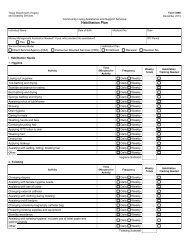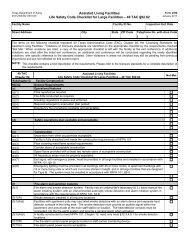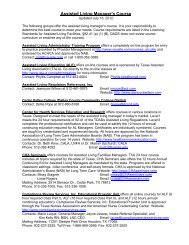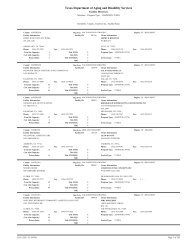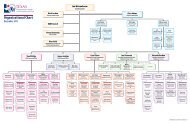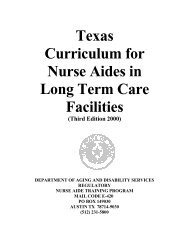Aging and Disability Services Council Sharon Swift Butterworth ...
Aging and Disability Services Council Sharon Swift Butterworth ...
Aging and Disability Services Council Sharon Swift Butterworth ...
You also want an ePaper? Increase the reach of your titles
YUMPU automatically turns print PDFs into web optimized ePapers that Google loves.
(G) a residential facility operated by the Texas Youth Commission, a jail, or prison; or<br />
(H) a setting in which two or more dwellings, including units in a duplex or apartment<br />
complex, single family homes, or facilities listed in subparagraphs (A)-(G) of this paragraph, but<br />
excluding supportive housing under Section 811 of the National Affordable Housing Act of<br />
1990, meet all of the following criteria:<br />
(i) the dwellings create a residential area distinguishable from other areas primarily occupied<br />
by persons who do not require routine support services because of a disability;<br />
(ii) most of the residents of the dwellings are persons with mental retardation, a related<br />
condition, or a physical disability; <strong>and</strong><br />
(iii) the residents of the dwellings are provided routine support services through personnel,<br />
equipment, or service facilities shared with the residents of the other dwellings.<br />
(50) Physical therapy--The provision of physical therapy as defined in Texas Occupations<br />
Code, Chapter 453.<br />
(51) Physician--A person who is licensed as a physician by the Texas State Board of Medical<br />
Examiners in accordance with Chapter 155 of the Texas Occupations Code or is licensed as<br />
physician or osteopath in accordance with the laws of Oklahoma, New Mexico, Arkansas, or<br />
Louisiana.<br />
(52) Prevocational services--<strong>Services</strong> that are not job-task oriented <strong>and</strong> are provided to an<br />
individual who the service planning team does not expect to be employed (without receiving<br />
supported employment) within one year after prevocational services are to begin, to prepare the<br />
individual for employment. Prevocational services consist of:<br />
(A) assessment of vocational skills an individual needs to develop or improve upon;<br />
(B) individual <strong>and</strong> group instruction regarding barriers to employment;<br />
(C) training in skills:<br />
(i) that are not job-task oriented;<br />
(ii) that are related to goals identified in the individual's habilitation plan;<br />
(iii) that are essential to obtaining <strong>and</strong> retaining employment, such as the effective use of<br />
community resources, transportation, <strong>and</strong> mobility training; <strong>and</strong><br />
(iv) for which an individual is not compensated more than 50 percent of the federal minimum<br />
wage or industry st<strong>and</strong>ard, whichever is greater;<br />
(D) training in the use of adaptive equipment necessary to obtain <strong>and</strong> retain employment;<br />
- 17 -



